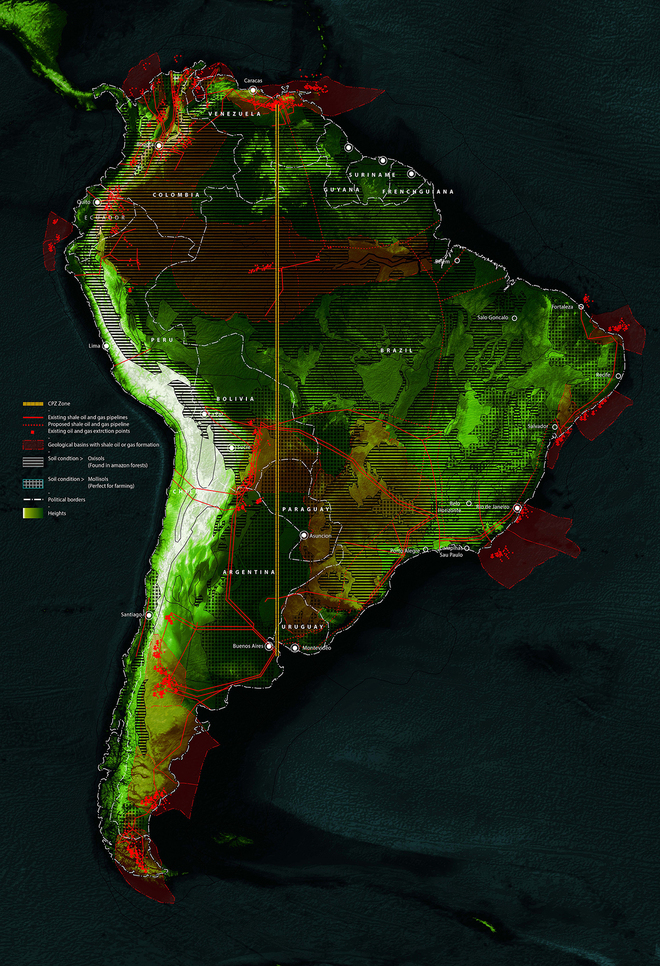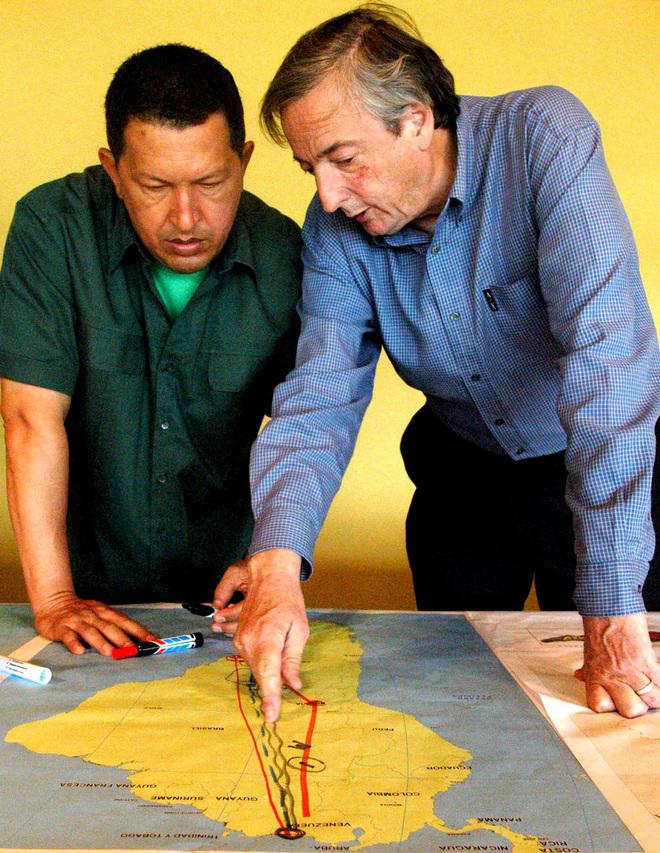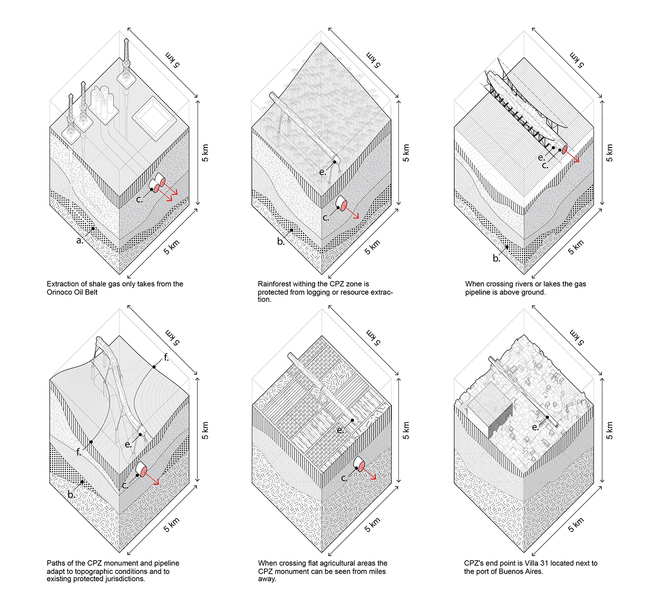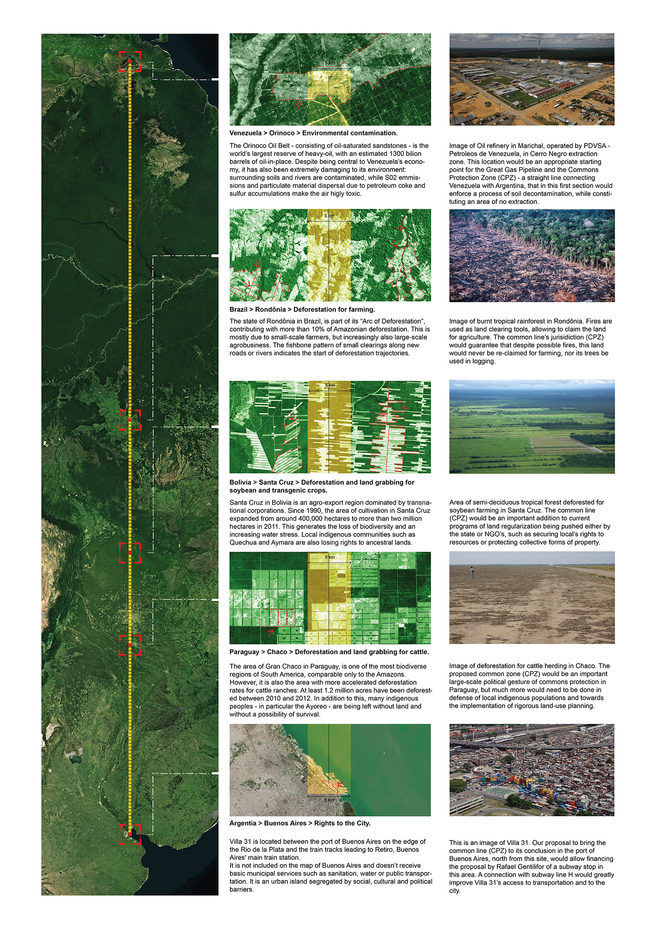-
-
-
-
-
Projects/
GODOFREDO PEREIRA + SAMANEH MOAFI:
GSAP/
GREAT SOUTH AMERICAN PIPELINE
-
GREAT SOUTH AMERICAN PIPELINE (GSAP): A COMMONS PROTECTION ZONE
Imagine the possibility of subtracting 1000 pixels from a deep map of South America: a map indicating the location of subterranean gas and oil reservoirs, describing soil conditions for large-scale agriculture and classifying preferential areas for livestock; a map setting the conditions for further urban and infrastructural expansion. Imagine the possibility of subtracting 1000 pixels – 5x5x5 km each – from this map, for the constitution of a commons protection zone.
-

-
In 2005 Presidents Hugo Chávez from Venezuela and Nestor Kirchner from Argentina met in Buenos Aires to discuss a proposal that would radically transform energy politics in South America. It was a proposal for a gas pipeline connecting the Orinoco Oil Belt in Venezuela to Argentina, cutting across the Amazonian rainforest and the Argentinean plains, and allowing for ramifications into other South American nations. Named “Gran Gasoducto del Sur”, it would be the most daring intervention in a political process of regional sovereignty and economic independence that attempted to take control over the continuous exploitation of South America’s "open veins" against colonial and post-colonial agents from the ‘global north’.
The photo-op of this encounter shows Chávez and Kirchner tracing a straight line across some of the most protected areas of the world, apparently oblivious of the environmental and indigenous concerns that would be raised by the project. Indeed, the inherently modernist nature of such gesture foregrounds what have been key political disputes within the left in South America: on the one hand a common political project of national and regional sovereignty based on resource nationalization, and on the other, massive social movements of landless peasants, indigenous populations and environmental activists, fighting back against the expansion of extractive economies.
-

In November 2005 President of Venezuela Hugo Chávez met President of Argentina Nestor Kirchner to discuss the "Gran Gasoducto del Sur" (Great Gas Pipeline of the South), a symbol of South American energetic and political sovereignty.
-
We understand Chavez and Kirchner’s idea from a geopolitical perspective, as a continuous monument to South America’s struggles for social emancipation. However, we would not build it as originally planned. Instead, we argue that its political dimension should be radicalized to its furthest consequences – to the point where the circulation of hydrocarbons is seen as a means for a trade-off: re-conceived as part of a "commons line", the construction of this gas pipeline would allow implementing a politics of subtraction to the logic of capitalist expansion:
We propose that 15% of expected revenues deriving from gas distribution, should be invested in the constitution of a Commons Protection Zone (CPZ) traced along the 5000km of the gas pipeline, as a continuous 5km strip of land with an exceptional legal framework agreed by all the member countries: a zone free of resource extraction such as hydrocarbons and minerals, but also of large scale agribusinesses such as cattle herding and soybean plantations. A zone where along its path, profits from gas distribution would be invested not only in the protection of existing commons, but also in the constitution of new ones.
-

-

Diagram of energetic integration in South America. Existing gas connections are to be superseded by CPZ and its future ramifications. Each hydrocarbon proposal should be accompanied by a commons protection zone.
-
To guarantee that such trade-off would take place, we propose the pipeline should be built at the same rate that the CPZ is implemented. Each nation connecting to the pipeline would be required to expand the protection zone along its connection, guaranteeing that a subtraction program should be implemented by every new gas link. At 25,000km2 this would constitute the world's largest commons project, bridging in the same move the difficult coexistence of a political struggle for post-colonial resource sovereignty with struggles for indigenous rights, environmental protection and anti-land-grabbing movements.
-

-
Along the CPZ are located some of the most disputed lands in South America from which we have selected 5 cases: the Orinoco Oil belt in Venezuela, witness to drastic environmental contamination by the oil industry; Rondônia in Brazil, whose forests have been devastated by accelerated urbanization and farming; Santa Cruz in Bolivia, where soybean plantations are forcing a massive deforestation and dispossession of indigenous communities; Chaco in Paraguay, whose unique biodiversity is being destroyed by large scale cattle herding; and Villa 31 in Argentina, a slum at the centre of a dramatic dispute over urban regeneration and the rights to the city.
In here we do not propose to design each condition. Instead, we want to evidence the spatial realities against which a Commons Protection Zone would be implemented. Of course not every condition would bring along an architectural or urban project, but surely all of them would benefit from such trade-off – a unique proposal towards non-capitalist forms of territorial politics.
-
-
-
-
-
-
-
©2012 The authors and contributors
-